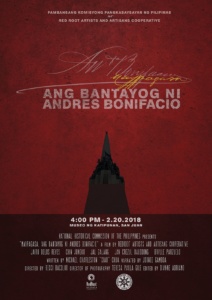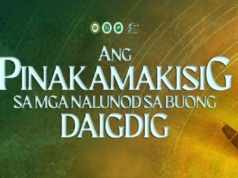By Michael “Xiao” Chua | February 10, 2018
I WAS given a great opportunity to fulfill a long-time dream—to make the state documentary on the life of President Andres Bonifacio to be narrated by the iconic voice that inspired me to become a historian—Joonee Gamboa. On February 20, 2018, the National Historical Commission of the Philippines and Red Root Artists and Artisans Cooperative will premiere “May pagasa: Ang Bantayog ni Andres Bonifacio” at the Museo ng Katipunan, Pinaglabanan, San Juan. The documentary will be made available to everyone for free via the NHCP YouTube.
The release of our documentary coincides with the announcement by Leon Gallery that they will be auctioning in five lots the Andres Bonifacio Presidential Letters from the Emmanuel Encarnacion Collection. The letters were used extensively in the Maypagasa documentary.
These four letters and an envelope bear the roundel escutcheon seal of Andres Bonifacio with the Baybayin “K” that emanates the light of freedom, like the sun with the words “Haring Bayang Katagalugan Kataas-taasang Kapulungan” (Sovereign Nation of the Tagalogs, Executive Cabinet) and his signature “Andres Bonifacio Maypagasa.” The different letters also tell us of his titles in the first national revolutionary government—P. (Pangulo) ng K. (Kataastaasan) Kapulungan (President of the Executive Cabinet), Ang K. (Kataastaasang) Plo. (Pangulo) (His Excellency, The President), and “Ang Plo. (Pangulo) ng H. B. (Haring Bayan) (The President of the Sovereign Nation). His appointment papers for Emilio Jacinto as General-in-Chief of the “Hilagaan” High Council of Manila dated April 15, 1897 is not just evidence of a Katipunan government which existed outside of Cavite at the time but also of the claim made by Andres Bonifacio that he founded the Katipunan. The letterhead reads “M. ANDRES BONIFACIO MAYPAGASA PANGULO NANG HARING BAYANG KATAGALUGAN, MAYTAYO NANG K. K. KATIPUNAN NANG MGA ANAK NANG BAYAN AT UNANG NAG GALAW NANG PANGHIHIMAGSIK.”
Aside from the envelope and the appointment papers, there were letters from Andres Bonifacio to Emilio Jacinto dated March 8, April 16 and April 24, 1897, written in the last weeks of his life where he related his feelings about the Cavite affair, which eventually led to his death. Each of the five items will be sold separately in an auction on March 3, 2018.
In fairness to collectors Cacho and Encarnacion, they made these documents available for free to researchers and allowed the publication of their contents and facsimiles to the general public for various uses, including children’s books on Bonifacio. These documents were used in the 1990s by Encarnacion, together with historians Milagros Guerrero and the late Ramon Villegas, to reconstruct the evidence that prove the existence of a national revolutionary government led by Andres Bonifacio, who rarely, if not never, signed himself as “Supremo.”
These documents, once doubted by Glenn May in his book Inventing a Hero: The Posthumous Re-Creation of Andres Bonifacio, is now verified as authentic by the documents in the recent book by Jim Richardson, The Light of Liberty, which sheds light on other Bonifacio papers at the Archivo General Militar de Madrid in Spain, bearing the same embellished handwriting, signature and seal.
Being just a few of the only ones that remain in the Philippines, the Bonifacio Presidential Letters is probably one of the—if not the—most important historical collectibles ever.
That said, I really wish that the government could afford to buy the documents to become part of the patrimony of the Filipino people. I am speculating that these were offered beforehand to government agencies. But since the documents were legally acquired, we hope that the ones who will eventually own these letters will not be foreigners, and that whoever will own them will decide to loan them to a museum. Because, as Encarnacion wrote, “This legacy is extremely important since it represents the birth of the Filipino nation, and our national heritage of the very first Filipino-run national government.”
For the words encoded in these relics—Haring Bayan—embodied our founding fathers’ imagination, when they first dreamed of a democratic nation—where the people have power.
Source:
































